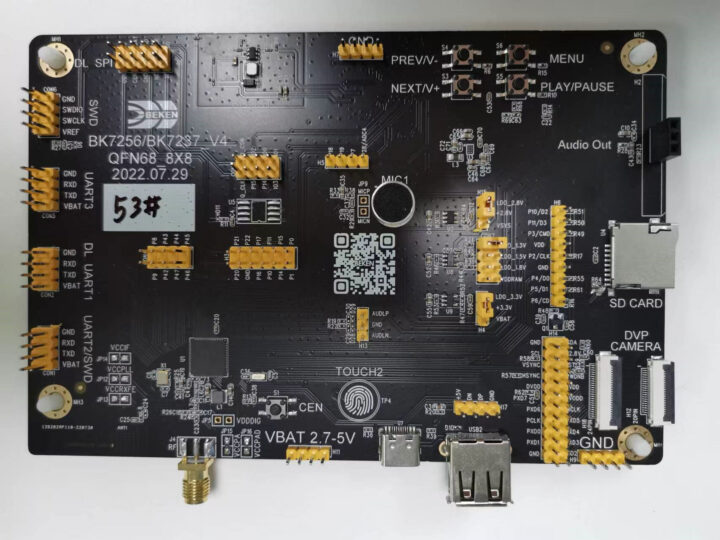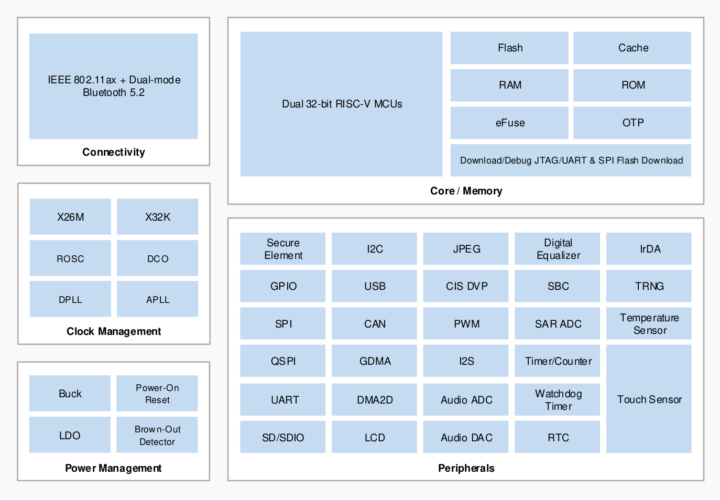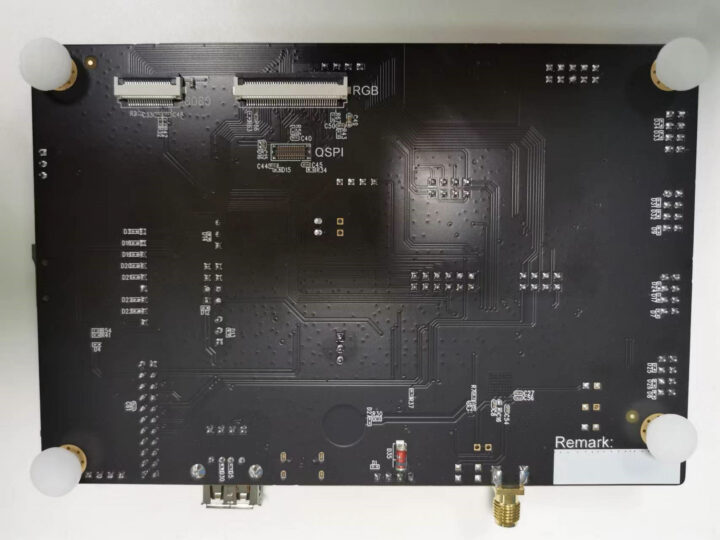Until now, I had only heard about Beken Bluetooth audio chips, but I’ve just been informed the company is also making WiFi chips such as the BK7256 that are notably found in some Tuya Smart Home modules.
Beken offers both RISC-V and Arm WiFi and Bluetooth chips with features summarized as follows:
- BK7235 single-core RISC-V MCU up to 320 MHz with 2.4 GHz WiFi 6 802.11ax and Bluetooth 5.2 LE, 4MB flash, 512KB SRAM, optional 4MB PSRAM
- BK7236 dual-core Arm MCU up to 120 to 240 MHh with 2.4 GHz WiFi 6 802.11ax and Bluetooth 5.3 dual mode, 4MB flash, 512KB SRAM, optional 4MB PSRAM
- BK7237 dual-core RISC-V MCU up to 320 MHz with 2.4 GHz WiFi 6 802.11ax and Bluetooth 5.2 dual mode, 4 or 8MB flash, 512KB SRAM, optional 4MB PSRAM
- BK7256 dual-core RISC-V MCU up to 320 MHz with 2.4 GHz WiFi 6 802.11ax and Bluetooth 5.2 dual mode, 4MB flash, 512KB SRAM, 8MB PSRAM, JPEG encoder
Let’s look into the KB7256 specifically, and see what software support and development kits are available for the Beken WiFi chips.
Beken BK7256 specifications:
- CPU – Dual-core 32-bit RISC-V MCU at up to 320 MHz with FPU, MPU, 32KB I/D TCM, 64 I-cache, and 16KB D-cache per core; EEMBC CoreMark score: 1 core at 320 MHz: 3.57 CoreMark/MHz
- System Memory – 512 KB shared SRAM, 8 MB SiP PSRAM
- Storage – 4 MB SiP flash, 64 KB ROM, 32 bytes eFuse, 8 Kbit OTP
- Video – JPEG hardware encoder/decoder
- Wi-Fi
- IEEE 802.11b/g/n/ax 1×1 compliant
- 20/40 MHz channel bandwidth for 2.4 GHz
- DL MU-MIMO and UL OFDMA support
- Individual Target Wake Time (iTWT)
- TX and RX low-density parity check (LDPC) support for extended range
- WPA/WPA2/WPA3-Personal support security
- Working mode: STA, AP, Direct, concurrent AP + STA
- Integrated BT/WLAN coexistence (PTA)
- TX power up to +18 dBm
- RX sensitivity -99 dBm
- Bluetooth
- Dual-mode Bluetooth 5.2 compliant
- Supports Basic Rate (BR), Enhanced Data Rate (EDR) 2 Mbps and 3 Mbps, Low Energy (LE) 1 Mbps, 2 Mbps, and long range (125 kbps and 500 kbps)
- Advertising extensions
- Bluetooth direction finding: Angle of Arrival (AoA) and Angle of Departure (AoD), plus antenna array with up to sixteen antennas for precise indoor positioning
- Peripherals
- 1x SD/SDIO
- Display – LCD interface (16-bit parallel RGB and I8080)
- Camera – 8-bit CIS DVP camera interface
- Audio – 1x I2S, 1x audio ADC, 1x audio DAC, four-band digital hardware equalizer, SBC decoder accelerator, microphone input amplifier, speakers amplifier
- USB – 1x full-speed USB OTG (FS)
- Up to 48 GPIOs
- 2x SPI, 1x QSPI, 2x I2C
- 3x UART: 1 with hardware flow control, 1 with flash download support
- 1x CAN controller with CAN FD
- Up to 12x 32-bit PWM
- Up to 8-channel 13-bit SAR ADC
- Up to 16x touch sensors
- 1x temperature sensor
- 1x IrDA
- DMA – 1xgeneral-purpose DMA controller (GDMA) with 6 channels, 1x DMA2D controller
- Timers
- 6x 32-bit general-purpose timer/counter
- 2x watchdog timer
- 1x real-time counter (RTC)
- Security
- Isolated secure element and hardware cryptography
- Secure boot
- Unique ID and secure storage
- Secure update and anti-rollback
- Lifecycle management such as secure debug
- Flash encryption
- Cryptographic hardware acceleration
- Crypto accelerator: DES, AES-128/192/256, ChaCha20-128/256, SM4-128
- Public key accelerator: ECDSA-P256/P384, RSA-2048/3072, SM2
- Hash: SHA-224/256, SHA-384/512, HMAC, Poly1305, SM3-512
- True Random Number Generator (TRNG)
- Clock Management
- External oscillator: 26 MHz crystal oscillator (X26M), 32.768 kHz crystal oscillator (X32K)
- Internal oscillator: 32 kHz ring oscillator (ROSC), 26 ~ 240 MHz digitally controlled oscillator (DCO)
- 320/480MHz PLL (DPLL)
- Audio PLL (APLL)
- Power Management
- 2.7 to 5.0 V VBAT supply
- On-chip power-on reset (POR) and brown-out detector (BOD)
- Embedded buck (DC-DC) converter and LDO regulators
- Power consumption:
- Active mode RX: 63 mA
- Active mode TX: 250 mA
- Low voltage standby mode: 150 μA
- Deep sleep mode: 15 μA
- Shutdown mode: 2.0 μA
- Package – 8x8mm QFN68 package
- Temperature Range – -40°C to +125°C

Beken provides development boards for each of their BK72XX microcontrollers and fairly detailed documentation in Chinese and English (some sections are not translated yet) where you’ll find the datasheets for the chip, instructions to get started, an API reference, and sample code for video, audio, Bluetooth, a doorbell, and command line usage. All new Beken chips (BK7235, BK7236, BK7237, BK7256) are supported by the Armino development framework hosted on GitHub. The framework currently works for FreeRTOS and LiteOS, and the company is also working on getting it ported to RT-Thread and AliOS.
Applications for the BK7256 include smart speakers, low power cameras, motor control, and Smart Home appliances. The chip is also found in one upcoming “Wi-Fi and Bluetooth Low Energy Combo Core Board” from Tuya. I could not find any BK7256 boards or modules on Aliexpress, and the official board might need to be sourced directly from Beken at this time.
Thanks to Rogan for the tip.

Jean-Luc started CNX Software in 2010 as a part-time endeavor, before quitting his job as a software engineering manager, and starting to write daily news, and reviews full time later in 2011.
Support CNX Software! Donate via cryptocurrencies, become a Patron on Patreon, or purchase goods on Amazon or Aliexpress







I think there is an error in the specs. In the video section, I assume they mean MJPEG and not JPEG 🙂
I suppose it could be, or they just used the terms interchangeably. They only use the term JPEG in the datasheet: 4.18 JPEGThe BK7256 embeds a JPEG encoder/decoder that can encode and decode a JPEG stream. It provides a small hardwarecompressor and a decompression accelerator of JPEG images. The JPEG encoder supports up to 32 programmablequantization tables.4.19 Camera InterfaceThe 8-bit CMOS Image Sensor (CIS) Digital Video Port (DVP) camera interface provides 8-bit parallel port interface to asensor, together with main clock (MCLK), pixel clock (PCLK), Horizontal SYNC (HSYNC) and Vertical SYNC (VSYNC)signals. Supported sensors could be but not limited to… Read more »
There’s no mjpeg standard to claim compatibility with. The format is just individual jpeg frames packed serially without any inter-frame techniques.
In other words, any hardware that has jpeg acceleration does mjpeg.
Anyhow, my pet peeve with the current crop of MCUs is that I’m not seeing benchmarks feed encryption + video compression + wifi encryption running simultaneously. After Anker’s Eufy affair you’d think manufactures would at least say something…
Why do makers of these “smart speaker” chips insist on baseline i2s paired with mono internal codec I cannot understand.
I asked Cypress why they added i2s to a chip with no audio capabilities (PSOC-5). The response was – the IP costs nothing, so it is there useful or not.
I knew beken only as one of the manufacturers of nrf24 clones, later then heard about leaked code for a beken chip that was very similar to boufalo chip pine64 wanted to reverse engineer.
I tried using this chip and running their own routines, the dvp camera output vga 25fps images, JPEG encoded, then JPEG_DEC displayed on the screen, and it worked well. Look at their documentation, support UVC, happen to have several UVC cameras on hand, test and verify their routines, found that some cameras when decoding display on the LCD screen have stripes, look carefully at their documentation, shows that when UVC output MJPEG data carrying DRI fields, stripes will appear. And high_speed is not supported.
I see that this chip supports Audio ADC and Audio DAC, and audio collection and playback can be realized without an external audio chip. I tried to use this chip, and ran their built-in routine, first recorded to a pcm file and saved it to the SD card, and then took the recorded file from the SD card to play, the sound quality is very good. I read the documentation and sdk of the chip, the information is very detailed, and it also provides a commonly used audio codec algorithm library and echo cancellation algorithm. This chip can complete the… Read more »